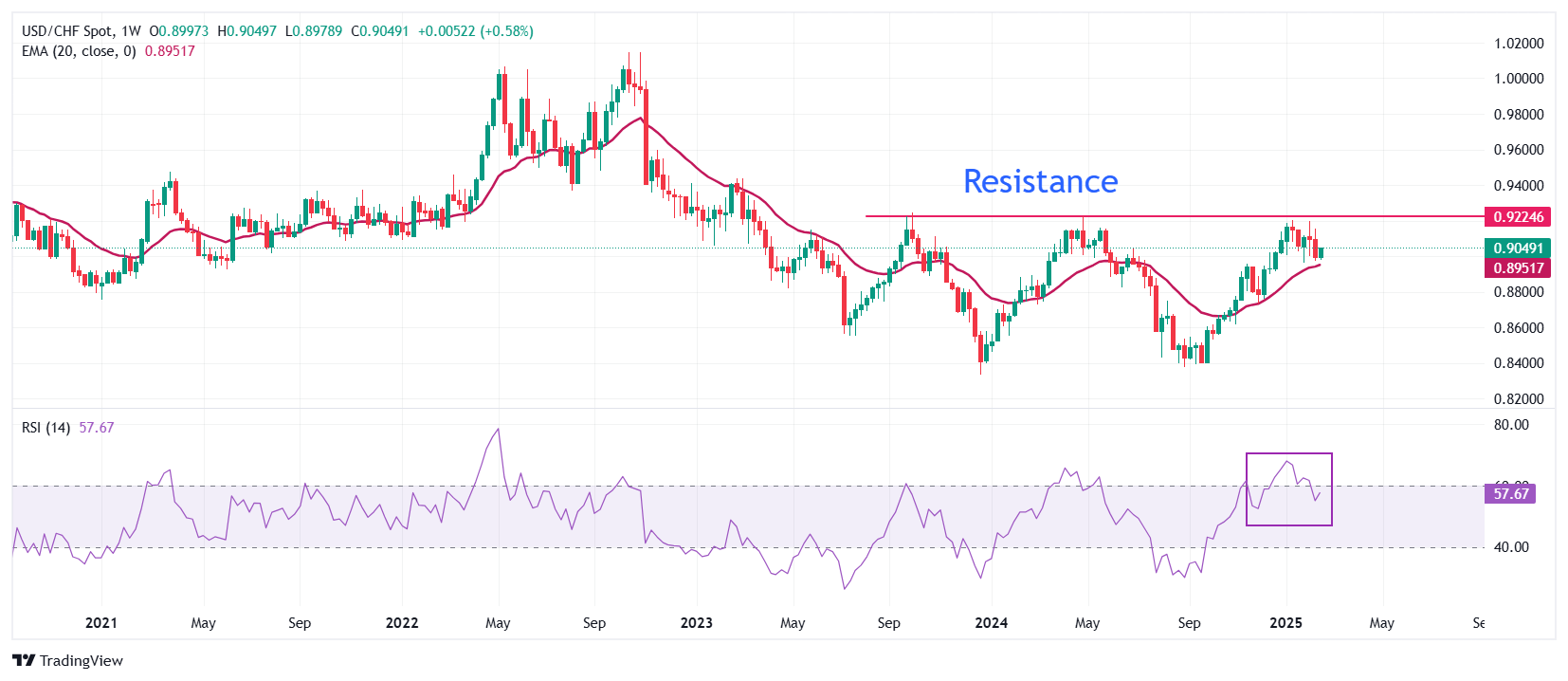USD/CHF Price Forecast: Extends winning streak for fourth trading day
- USD/CHF moves higher to near 0.9050 as the US Dollar ticks higher ahead of FOMC minutes.
- The Fed guided in January that interest rates will remain at their current levels until the labor market is strong and price pressures are sticky.
- The SNB is expected to follow an ultra-dovish monetary policy stance.
The USD/CHF pair extends its winning spree for the third trading day on Wednesday. The Swiss Franc pair gains to near 0.9050, while the US Dollar (USD) wobbles ahead of the Federal Open Market Committee (FOMC) minutes, which will be published at 19:00 GMT. The US Dollar Index (DXY), which gauges the Greenback’s value against six major currencies, trades near 107.00.
Investors await the FOMC minutes for the January policy meeting to get cues about how long the Federal Reserve (Fed) will continue with its restrictive monetary policy stance. The Fed left interest rates steady in the range of 4.25%-4.50% in January and guided that monetary policy adjustments won’t be appropriate until officials see “real progress in inflation or at least some weakness in the labor market”.
Meanwhile, the market sentiment is slightly favorable for risk-sensitive assets even though United States (US) President Donald Trump threatens to raise 25% tariffs on foreign cars, pharmaceuticals and semiconductors. It appears that investors are less concerned about Trump’s tariffs due to the absence of details about the timeframe.
The Swiss Franc (CHF) underperforms broadly as the Swiss National Bank (SNB) is expected to adopt an ultra-dovish monetary policy stance to uplift inflationary pressures, which have come down to 0.4%, the lowest level seen since May 2021.
USD/CHF strives to revisit its 15-month high, around 0.9200. The outlook of the Swiss Franc pair remains firm as the 20-week Exponential Moving Average (EMA) near 0.8950 is sloping higher.
The 14-week Relative Strength Index (RSI) falls into the 40.00-60.00 from the bullish range of 60.00-80.00, suggesting that the upside momentum has faded. However, the upside bias is intact.
For a fresh upside toward the round-level resistance of 0.9300 and the 16 March 2023 high of 0.9342, the asset needs to break decisively above the October 2023 high of 0.9244.
On the flip side, a downside move below the psychological support of 0.9000 would drag the asset towards the November 22 high of 0.8958, followed by the December 16 low of 0.8900.
USD/CHF weekly chart
US Dollar FAQs
The US Dollar (USD) is the official currency of the United States of America, and the ‘de facto’ currency of a significant number of other countries where it is found in circulation alongside local notes. It is the most heavily traded currency in the world, accounting for over 88% of all global foreign exchange turnover, or an average of $6.6 trillion in transactions per day, according to data from 2022. Following the second world war, the USD took over from the British Pound as the world’s reserve currency. For most of its history, the US Dollar was backed by Gold, until the Bretton Woods Agreement in 1971 when the Gold Standard went away.
The most important single factor impacting on the value of the US Dollar is monetary policy, which is shaped by the Federal Reserve (Fed). The Fed has two mandates: to achieve price stability (control inflation) and foster full employment. Its primary tool to achieve these two goals is by adjusting interest rates. When prices are rising too quickly and inflation is above the Fed’s 2% target, the Fed will raise rates, which helps the USD value. When inflation falls below 2% or the Unemployment Rate is too high, the Fed may lower interest rates, which weighs on the Greenback.
In extreme situations, the Federal Reserve can also print more Dollars and enact quantitative easing (QE). QE is the process by which the Fed substantially increases the flow of credit in a stuck financial system. It is a non-standard policy measure used when credit has dried up because banks will not lend to each other (out of the fear of counterparty default). It is a last resort when simply lowering interest rates is unlikely to achieve the necessary result. It was the Fed’s weapon of choice to combat the credit crunch that occurred during the Great Financial Crisis in 2008. It involves the Fed printing more Dollars and using them to buy US government bonds predominantly from financial institutions. QE usually leads to a weaker US Dollar.
Quantitative tightening (QT) is the reverse process whereby the Federal Reserve stops buying bonds from financial institutions and does not reinvest the principal from the bonds it holds maturing in new purchases. It is usually positive for the US Dollar.

